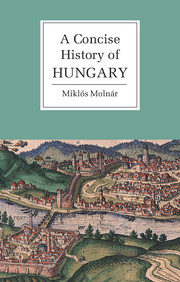Book contents
- Frontmatter
- Contents
- List of illustrations
- Acknowledgements
- Chronology
- 1 FROM THE BEGINNINGS UNTIL 1301
- 2 GRANDEUR AND DECLINE: FROM THE ANGEVIN KINGS TO THE BATTLE OF MOHÁCS, 1301–1526
- 3 A COUNTRY UNDER THREE CROWNS, 1526–1711
- 4 VIENNA AND HUNGARY: ABSOLUTISM, REFORMS, REVOLUTION, 1711–1848/9
- 5 RUPTURE, COMPROMISE AND THE DUAL MONARCHY, 1849–1919
- 6 BETWEEN THE WARS
- 7 UNDER SOVIET DOMINATION, 1945–1990
- 8 1990, A NEW DEPARTURE
- Bibliographical notes
- Index
3 - A COUNTRY UNDER THREE CROWNS, 1526–1711
Published online by Cambridge University Press: 05 June 2014
- Frontmatter
- Contents
- List of illustrations
- Acknowledgements
- Chronology
- 1 FROM THE BEGINNINGS UNTIL 1301
- 2 GRANDEUR AND DECLINE: FROM THE ANGEVIN KINGS TO THE BATTLE OF MOHÁCS, 1301–1526
- 3 A COUNTRY UNDER THREE CROWNS, 1526–1711
- 4 VIENNA AND HUNGARY: ABSOLUTISM, REFORMS, REVOLUTION, 1711–1848/9
- 5 RUPTURE, COMPROMISE AND THE DUAL MONARCHY, 1849–1919
- 6 BETWEEN THE WARS
- 7 UNDER SOVIET DOMINATION, 1945–1990
- 8 1990, A NEW DEPARTURE
- Bibliographical notes
- Index
Summary
AFTER MOHÁCS
Suleiman I the Magnificent (1520–66), victor on the battlefield of Mohács, did not immediately set about exploiting his victory. During his long reign he extended his empire in the East, in Algeria and in Tripolitania. He was also a great legislator. His imperial ambitions focused on Austria and Europe as well as on Hungary but he conducted his wars according to flexible policies and concepts and spread them out in time and space. His successors, Selim II (1566–74) and Murad III (1574–95) would follow suit.
After Mohács, Suleiman went to Buda, then left the capital, and in October left Hungary, but kept a firm hold on strategic forts in the south. The capital had surrendered without resistance. It was a dead city, empty, abandoned. According to György Szerémi, a priest–chronicler, the only people left were ‘the poor, the crippled, the blind and the simpletons’. He soon joined the German burghers fleeing the pillaging Magyars, taking St János's golden urn with him.
Far from the battlefield, the palatine, Báthori, was in his turn busy pillaging the royal treasury, while the commander of Esztergom – seat of the bishopric – aided by his men, plundered the queen's boats and her ladies in waiting. Queen Marie of Habsburg, meanwhile, in fear of the Magyars – whose first reaction appears to have been to celebrate having rid themselves of the royal couple rather than to mourn Mohács – fled to Pozsony and then on towards the lands of her brother, the emperor.
- Type
- Chapter
- Information
- A Concise History of Hungary , pp. 87 - 138Publisher: Cambridge University PressPrint publication year: 2001



